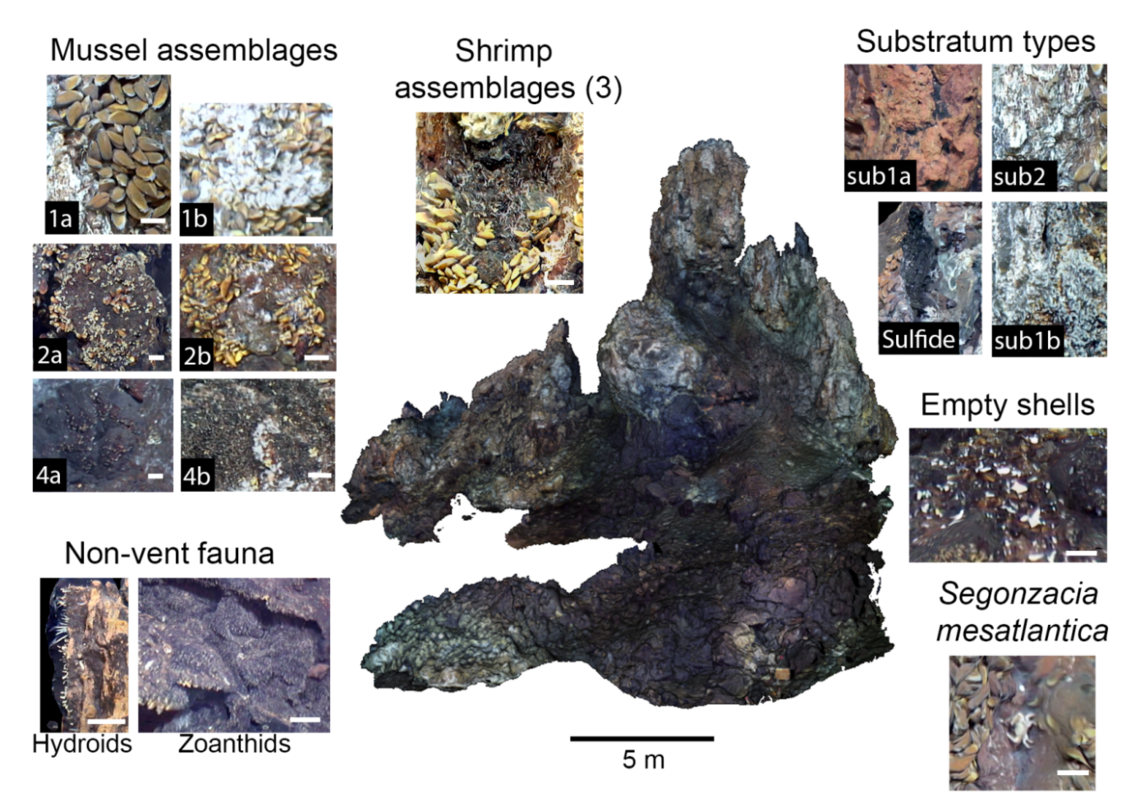3D reconstruction of an active hydrothermal edifice
The 3D reconstruction of the active Eiffel Tower edifice offers a new perspective on deep hydrothermal vents. This immersion at 1700 m provided new answers on factors that influence the spatial distribution of associated faunal communities.
The Eiffel Tower hydrothermal edifice, hosting the eastern node of the EMSO-Azores observatory, is one of the most studied active edifice in the world. Since its discovery in 1992, it has been the subject of a large number of studies (Cuvelier et al. 2011, Sarrazin et al. 2014, 2015, 2020). The numerous sampling and image acquisition strategies contributed to highlight the role of physico-chemical factors such as temperature, sulphide and iron concentrations, on the distribution of macrofaunal communities at the scale of the edifice (Cuvelier et al., 2009; Cuvelier et al., 2011, Sarrazin et al. 2015, Husson et al. 2017). However, nothing was known about the influence of the topography and roughness of the substratum on the observed patterns. But habitat complexity can play a significant role on the structure of benthic communities, as it is the case in coastal environments where biogenic structures (mussels, corals, seagrass beds) are often associated with higher diversity and abundance. (Koivisto & Westerbom, 2010). The difficulty in reconstructing the complexity of hydrothermal structures and the absence of small-scale current measurements prevented us from examining the combined role of topography and bottom currents.
The reconstruction of Eiffel Tower, using a photogrammetry approach, contributed to remove these obstacles. In 2015, a complete coverage of the edifice from video transects carried out with the ROV Victor6000 resulted in the reconstruction of a first 3D model. These data were coupled to those obtained from a current meter deployed tens of meters from the edifice to evaluate the combined role of topography, smoker positions and benthic currents on the distribution of faunal communities. Exposure and distance to smokers explained the observed size differences between mussel assemblages and distribution of microbial mats (Girard et al., 2020). Repeated site visits during maintenance cruises allowed the reconstruction of additional models in 2016, 2018 and if all goes well, a new model will emerge from Momarsat 2020! Their analyses will allow a better understanding of the temporal variability of these factors and their impacts on the distribution patterns of communities and therefore assessing the stability of the ecosystem over time.
This 3D model was also imported into a virtual environment and offers, through a virtual reality headset, an immersion in the heart of Lucky Strike, at 1700m. Not only does this approach have undeniable advantages in terms of communication with the general public or managers, but also opens new perspectives to understanding this complex environment. It has even become an essential tool for preparing dives!
← Read the 10 success stories published to celebrate 10 years of monitoring on EMSO-Azores →
|
References
Cuvelier, D., Sarradin, P.-M., Sarrazin, J., Colaco, A., Copley, J. T. P., Desbruyères, D., Glover, A. G., Santos, R. S., & Tyler, P. a. (2011). Hydrothermal faunal assemblages and habitat characterisation at the Eiffel Tower edifice (Lucky Strike, Mid-Atlantic Ridge). Marine Ecology, 32(2), 243–255. https://doi.org/10.1111/j.1439-0485.2010.00431.x
Cuvelier, D., Sarrazin, J., Colaco, A., Copley, J. T. P., Desbruyères, D., Glover, A. G., Tyler, P. A., & Serrão Santos, R. (2009). Distribution and spatial variation of hydrothermal faunal assemblages at Lucky Strike (Mid-Atlantic Ridge) revealed by high-resolution video image analysis. Deep-Sea Research Part I: Oceanographic Research Papers, 56, 2026–2040. https://doi.org/10.1016/j.dsr.2009.06.006
Cuvelier, D., Sarrazin, J., Colaco, A., Copley, J. T. P., Glover, A. G., Tyler, P. A., Santos, R. S., & Desbruyères, D. (2011). Community dynamics over 14 years at the Eiffel Tower hydrothermal edifice on the Mid-Atlantic Ridge. Limnology and Oceanography, 56(5), 1624–1640.
Girard, F., Sarrazin, J., Arnaubec, A., Cannat, M., Sarradin, P.-M., Wheeler, B., & Matabos, M. (2020). Currents and topography drive assemblage distribution on an active hydrothermal edifice. Progress in Oceanography, 187.
Koivisto, M. E., & Westerbom, M. (2010). Habitat structure and complexity as determinants of biodiversity in blue mussel beds on sublittoral rocky shores. Marine Biology, 157(7), 1463–1474. https://doi.org/10.1007/s00227-010-1421-9
Sarrazin, J., Cuvelier, D., Peton, L., Legendre, P., & Sarradin, P.-M. (2014). High-resolution dynamics of a deep-sea hydrothermal mussel assemblage monitored by the EMSO-Açores MoMAR observatory. Deep Sea Research Part I: Oceanographic Research Papers, 90, 62–75. https://doi.org/10.1016/j.dsr.2014.04.004
Sarrazin, J., Legendre, P., de Busserolles, F., Fabri, M.-C., Guilini, K., Ivanenko, V. N., Morineaux, M., Vanreusel, A., & Sarradin, P.-M. (2015). Biodiversity patterns, environmental drivers and indicator species on a high-temperature hydrothermal edifice, Mid-Atlantic Ridge. Deep Sea Research Part II: Topical Studies in Oceanography, 121, 177–192. https://doi.org/10.1016/j.dsr2.2015.04.013
Sarrazin, J., Portail, M., Legrand, E., Cathalot, C., Laes, A., Lahaye, N., Sarradin, P. M., & Husson, B. (2020). Endogenous versus exogenous factors: What matters for vent mussel communities? Deep-Sea Research Part I: Oceanographic Research Papers, 160(February), 103260. https://doi.org/10.1016/j.dsr.2020.103260


